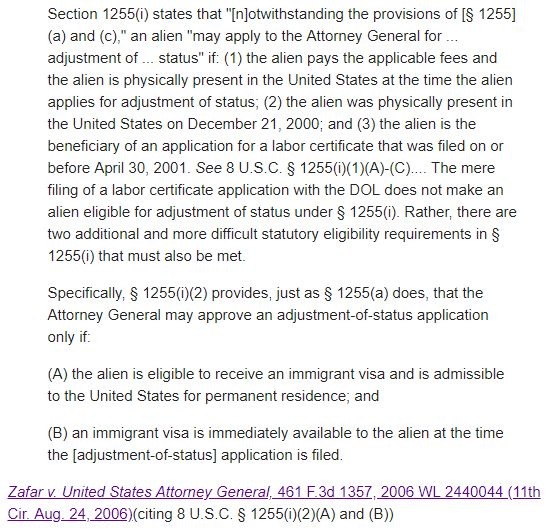Merchant v. U.S. Atty. Gen. (11th Cir. 2006): Vacating Denial of Continuance for Alien Who Met Requirements for 245(i)

- Introduction: Merchant v. U.S. Atty. Gen., 461 F.3d 1375
- Factual and Procedural History: 461 F.3d at 1376
- Eleventh Circuit Analysis and Conclusions: 461 F.3d at 1377-80
- Citing Reference in Matter of L-A-B-R-, et al., 27 I&N Dec. 405 (A.G. 2018)
- Conclusion
Introduction: Merchant v. U.S. Atty. Gen., 461 F.3d 1375
On August 25, 2006, the United States Court of Appeals for the Eleventh Circuit published a precedential decision in Merchant v. U.S. Atty. Gen., 461 F.3d 1375 (11th Cir. 2006) [PDF version]. In Merchant, a three-judge panel of the Eleventh Circuit vacated the unpublished decision of the Board of Immigration Appeals (BIA) which had affirmed an immigration judge's denial of continuance to a respondent who had completed all of the prerequisites for adjustment of status.
Merchant gained increased significance in light of a favorable reference to the decision by Attorney General Jeff Sessions in Matter of L-A-B-R-, 27 I&N Dec. 405 (A.G. 2018). In Matter of L-A-B-R-, the Attorney General established rules for what constitutes “good cause” for a continuance for an alien to seek collateral relief from removal. While the decision generally imposed more restrictive rules on evaluating such motions for continuance, the Attorney General cited to Merchant as an example of a situation where the equities weighed in favor of granting a motion for continuance.
In this article, we will examine the Merchant decision in detail before assessing its significance in Matter of L-A-B-R-.
The decision was authored by Judge R. Lanier Anderson III.
To learn about Matter of L-A-B-R- and continuances more generally, please see our full article index on the subject [see index]. To learn about the jurisdiction of the Eleventh Circuit and other Federal circuit courts, please see our article on that subject [see article].
Factual and Procedural History: 461 F.3d at 1376
The petitioner, Firoz Ali Merchant, was a native and citizen of Pakistan. He entered the United States on a nonimmigrant visa on October 31, 2000. Under the terms of his admission, he was authorized to remain no later than April 30, 2001. Merchant overstayed his visa.
On July 3, 2002, the former Immigration and Naturalization Service (INS) — since supplanted by the Department of Homeland Security (DHS) — initiated removal proceedings against Merchant, charging him as being removable under section 237(a)(1)(B) of the Immigration and Nationality Act (INA) for remaining longer than permitted.
In his removal hearing on December 10, 2002, Merchant conceded that he was removable as charged. Merchant then filed a motion for administrative closure or termination on the basis that he had a pending labor certificate and hoped to file for adjustment of status under section 245(i) of the INA. These were construed as motions for continuance. In July of 2003, Merchant filed documents with the immigration court establishing that his labor certification application had been approved and that a Form I-140 immigrant visa petition had been filed on his behalf along with his concurrent Form I-485 application for adjustment of status, both based on the approved labor certification.
On September 25, 2003, the immigration judge decided Merchant's case along with several others that raised the same issue, denying Merchant's motion for a continuance. The immigration judge reasoned that the pendency of the immigrant visa petition did not entitle the alien to a continuance. Furthermore, the immigration judge determined that he lacked authority to determine prima facie (on the face) eligibility for an employment-based visa.
Merchant appealed from the denial to the BIA, but his appeal was dismissed. The Board wrote that Merchant's “speculative future eligibility for adjustment of status failed to establish good cause for a continuance of his removal proceedings.” The Board rejected Merchant's reliance on Subhan v. Ashcroft, 383 F.3d 591 (7th Cir. 2004) [PDF version], a precedent decision of the United States Court of Appeals for the Seventh Circuit, wherein the Court vacated the affirmance of the denial of a continuance under similar circumstances because the immigration judge in that case had not provided the reasoning for the denial.
Merchant filed a petition for review with the Eleventh Circuit and a motion to reconsider with the BIA. The Board denied the motion to reconsider, leading Merchant to file a second petition for review with the Eleventh Circuit. The two petitions for review were consolidated in the instant case.
Eleventh Circuit Analysis and Conclusions: 461 F.3d at 1377-80
The Eleventh Circuit wrote that the issue was whether the immigration judge and the BIA committed an abuse of discretion in denying Merchant's motion for a continuance. The Eleventh Circuit had previously noted in Bull v. INS, 790 F.2d 869, 869 (11th Cir. 1986) [PDF version], that the decision whether to grant a continuance is a matter of discretion. The regulatory standard for granting a continuance, found in 8 C.F.R. 1003.29, is “good cause shown.”
In the instant case, Merchant sought a continuance on the basis that he had already obtained an approved labor certification and had properly filed a Form I-140 immigrant visa petition and Form I-485 adjustment of status application with INS. He sought adjustment under section 245(i) of the INA, which provides a limited exception for certain aliens seeking adjustment of status based on approved employment-based immigrant visa petitions to the section 245(c) bar on adjustment for overstays [see article]. Below, we except the Eleventh Circuit's discussion of the section 245(i) adjustment rules from its prior published decision in Zafar v. United States Attorney General, 461 F.3d 1357 (11th Cir. 2006) [PDF version]:

In Zafar, the Eleventh Circuit explained that, under section 245(i), merely filing a labor certification application does not render an alien eligible for adjustment. In the instant case, however, Merchant's labor certification application had already been approved, and he had also filed a Form I-140 and a Form I-485 based on the approved labor certification with INS/DHS. Merchant further argued that he satisfied all of the other statutory prerequisites for section 245(i), rendering him facially eligible for adjustment. In oral arguments before the Eleventh Circuit, the government conceded that Merchant had an approved labor certification application, that Forms I-140 and I-485 were filed on the basis of that approved labor certification, and that an immigrant visa number was immediately eligible in the area of Merchant's approved labor certification application.
The Eleventh Circuit, agreeing with Merchant's position, wrote that “[a]pparently, the government's only argument that Merchant had not satisfied all of [section 245(i)'s] requirements is that the immigrant visa is not in hand.” The government specifically argued that Merchant was not “eligible” for an immigrant visa because his immigrant visa petition had not yet been approved and he did not already have a visa in hand. However, the Eleventh Circuit rejected this position “because the statute clearly provides that an alien in Merchant's shoes need only be 'eligible' to receive the visa, not that he must have the visa in hand.'”
In Bull v. INS, 790 F.2d at 869, the Eleventh Circuit held that an immigration judge had abused his discretion when he “refused to grant a continuance despite the fact that the petitioner was married to a United States citizen and had filed the Form I-130 application for a family-based visa.” In Zafar, 461 F.3d at 1364, the Eleventh Circuit rejected the petitioners' reliance on Bull because the petitioners' had not received labor certifications and had not yet filed the Form I-140 and Form I-485. While the Eleventh Circuit noted that the fact Bull involved a “favored” immediate relative petition was a “distinguishing factor” from section 245(i) cases such as the instant case, it stated that “the two cases are somewhat similar in that both had applied for visas and both were eligible for them.” Thus, the Eleventh Circuit found the conclusion in Bull supportive of the conclusion it would ultimately reach in the instant case.
The Eleventh Circuit found it significant that Merchant had completed all of the statutory prerequisites for section 245(i) adjustment. The only things remaining undone were the issuance by DHS of a decision on the immigrant visa petition and a decision on adjustment. For these reasons, the Court found that Merchant was “eligible for an immigrant visa.” In footnote 6 to the decision, the Eleventh Circuit made clear that by “eligible,” it was referring to Merchant's completion of the statutory prerequisites, not that the DHS could not ultimately deny either the petition or the adjustment application in the exercise of its discretion. In light of these circumstances and Merchant's “advanced age,” the Eleventh Circuit concluded that the immigration judge and Board abused their discretion in denying the motion for continuance.
The Eleventh Circuit, however, clarified that its decision in no way mandated “indefinite continuances.” Instead, it invited the Board on remand to “provide guidance with regard to the duration of appropriate continuances in this (or other) circumstances.” It added that “additional relevant factors may well influence the BIA's decision on remand.”
Citing Reference in Matter of L-A-B-R-, et al., 27 I&N Dec. 405 (A.G. 2018)
In Matter of L-A-B-R-, et al., 27 I&N Dec. 405 (A.G. 2018) [PDF version] [see article], Attorney General Sessions established rules for what constitutes “good cause” for a continuance sought to seek collateral relief from removal. In the decision, the Attorney General discussed how to weigh positive and negative factors for and against granting a continuance in these circumstances. He stated that “[a] respondent who makes a compelling case that he will receive collateral relief and successfully adjust status may receive a continuance even if, for instance, he has already received previous continuances.” Id. at 417 [see section]. Here, the Attorney General cited to Merchant as an example of a case whose facts would potentially justify granting a continuance even if certain negative equities also exist.
Conclusion
Merchant remains a noteworthy decision in the case of an alien who satisfies all of the prerequisites for some form of collateral relief, and who as a result may have a definite time frame for a determination on whether he or she will be granted such relief. That the Attorney General cited to it favorably in Matter of L-A-B-R- is significant in light of the fact that L-A-B-R- generally tightened the rules for when an alien may be granted a continuance to pursue collateral relief.
It is important not to over-read into Merchant, a case where the alien had a relatively strong case that he would potentially be granted collateral relief from removal within a reasonable time frame. The Eleventh Circuit itself has since factually distinguished several cases from Merchant. In Scheerer v. U.S. Atty. Gen., 513 F.3d 1244, 1254 (11th Cir. 2008) [PDF version], the Court distinguished a case involving an arriving alien because the immigration court would have no jurisdiction over an adjustment application. In Chacku v. U.S. Atty. Gen., 555 F.3d 1281, 1286 (11th Cir. 2008) [PDF version], the Court agreed with the BIA that a case in which an alien files for adjustment based on an approved employment-based petition without having an immigrant visa number immediately available to him is distinguishable from Merchant. We discuss a similar case on this issue (not referenced by the Eleventh Circuit) in our article on Matter of Quintero, 18 I&N Dec. 348 (BIA 1982) [PDF version] [see article].
An alien facing removal proceedings should consult with an experienced immigration attorney immediately. An experienced attorney will be able to determine which paths, as any, the alien has for contesting the removal charges of seeking some other form of relief or protection.
For further discussion of issues examined in this article, please see our website's growing categories on removal and deportation defense [see category], adjustment of status [see category], and employment immigration [see category].